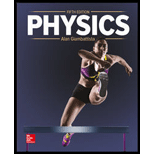
(a)
The value of the current in ammeter
(a)
Answer to Problem 112P
The value of the current in ammeter
Explanation of Solution
Write the expression for the current through the ammeter
Here,
Write the expression for the equivalent resistance.
Here,
Use equation (II) in (I) to solve for
Conclusion:
Substitute
Therefore, the value of the current in ammeter
(b)
The value of the current in ammeter
(b)
Answer to Problem 112P
The value of the current in ammeter
Explanation of Solution
Write the expression for the resistance across the branch through the ammeter
Write the expression for the potential difference right to the ammeter
Write the expression for the current through the ammeter
Use equation (IV) and (V) in (VI) to solve for
Conclusion:
Substitute
Therefore, the value of the current in ammeter
Want to see more full solutions like this?
Chapter 18 Solutions
Physics
- Power P0 = I0 V0 is delivered to a resistor of resistance R0. If the resistance is doubled (Rnew = 2R0) while the voltage is adjusted such that the current is constant, what are the ratios (a) Pnew/P0 and (b) Vnew/V0? If, instead, the resistance is held constant while Pnew = 2P0, what are the ratios (c) Vnew/V0, and (d) Inew/I0?arrow_forwardExplain why R=R0(1 + a?T) for the temperature variation of the resistance R of an object is not as accurate as P=P0(1 + a?T) which gives the temperature variation of resistivity P.arrow_forwardThe ammeter shown in Figure P21.45 reads 2.00 A. Find I1, I2, and . Figure P21.45arrow_forward
- Electric current I enters a node with three resistors connected in parallel (Fig. CQ18.5). Which one of the following is correct? (a) I1 = I and I2 = I3 = 0. (b) I2 I1 and I2 I3. (c) V1 V2 V3 (d) I1 I2 I3 0. Figure CQ18.5arrow_forwardThe values of the components in a simple series RC circuit containing a switch (Fig. P21.53) are C = 1.00 F, R = 2.00 106 , and = 10.0 V. At the instant 10.0 s after the switch is closed, calculate (a) the charge on the capacitor, (b) the current in the resistor, (c) the rate at which energy is being stored in the capacitor, and (d) the rate at which energy is being delivered by the battery.arrow_forwardElectric current I enters a node with three resistors connected in parallel (Fig. CQ18.5). Which one of the following is correct? (a) I1 = I and I2 = I3 = 0. (b) I2 I1 and I2 I3. (c) V1 V2 V3 (d) I1 I2 I3 0. Figure CQ18.5arrow_forward
- The power dissipated in a resistor is given by P = V2/R, which means power decreases if resistance increases. Yet this power is also given by P = I2R, which means power increases if resistance increases. Explain why there is no contradiction here.arrow_forwardIf the terminals of a battery with zero internal resistance are connected across two identical resistors in series, the total power delivered by the battery is 8.00 W. If the same battery is connected across the same resistors in parallel, what is the total power delivered by the battery? (a) 16.0 W (b) 32.0 W (c) 2.00 W (d) 4.00 W (e) none of those answersarrow_forwardConsider a series RC circuit as in Figure P18.35 for which R = 1.00 M, C = 5.00 F, and = 30.0 V. Find (a) the time constant of the circuit and (b) the maximum charge on the capacitor after the switch is thrown closed. (c) Find the current in the resistor 10.0 s after the switch is closed. Figure P18.35 Problem 35 and 38.arrow_forward
- Calculate the power delivered to each resistor in the circuit shown in Figure P21.43. Figure P21.43arrow_forwardThe capacitor shown below has an initial voltage of 0.15 V before the switch is closed. The resistance is 8.5 x 106 ohms and the capacitance is 2.0 microfarads. How long after the switch is closed in seconds does it take for the voltage across the resistor to drop to 0.083 V? R CH B A Darrow_forwardA battery is manufactured to have an emf of 24.0 V, but the terminal voltage is only 22.0 V when the battery is connected across a 10.0-Ω resistor. What is the internal resistance of the battery? 3.9 Ω 0.46 Ω 1.2 Ω 0.91 Ωarrow_forward
 Principles of Physics: A Calculus-Based TextPhysicsISBN:9781133104261Author:Raymond A. Serway, John W. JewettPublisher:Cengage Learning
Principles of Physics: A Calculus-Based TextPhysicsISBN:9781133104261Author:Raymond A. Serway, John W. JewettPublisher:Cengage Learning College PhysicsPhysicsISBN:9781938168000Author:Paul Peter Urone, Roger HinrichsPublisher:OpenStax College
College PhysicsPhysicsISBN:9781938168000Author:Paul Peter Urone, Roger HinrichsPublisher:OpenStax College College PhysicsPhysicsISBN:9781285737027Author:Raymond A. Serway, Chris VuillePublisher:Cengage Learning
College PhysicsPhysicsISBN:9781285737027Author:Raymond A. Serway, Chris VuillePublisher:Cengage Learning Physics for Scientists and Engineers: Foundations...PhysicsISBN:9781133939146Author:Katz, Debora M.Publisher:Cengage Learning
Physics for Scientists and Engineers: Foundations...PhysicsISBN:9781133939146Author:Katz, Debora M.Publisher:Cengage Learning College PhysicsPhysicsISBN:9781305952300Author:Raymond A. Serway, Chris VuillePublisher:Cengage Learning
College PhysicsPhysicsISBN:9781305952300Author:Raymond A. Serway, Chris VuillePublisher:Cengage Learning




